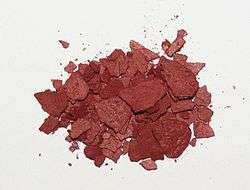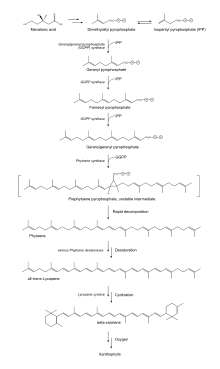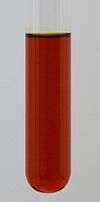Lycopene
Lycopene (from the neo-Latin Lycopersicum, the tomato species) is a bright red carotenoid hydrocarbon found in tomatoes and other red fruits and vegetables, such as red carrots, watermelons, grapefruits, and papayas, but it is not present in strawberries or cherries.[3] Although lycopene is chemically a carotene, it has no vitamin A activity.[4] Foods that are not red may also contain lycopene, such as asparagus, guava and parsley.[3]
 | |
 | |
| Names | |
|---|---|
| IUPAC name
(6E,8E,10E,12E,14E,16E,18E,20E,22E,24E,26E)- 2,6,10,14,19,23,27,31-Octamethyldotriaconta-2,6,8,10,12,14,16,18,20,22,24,26,30-tridecaene | |
| Other names
ψ,ψ-Carotene | |
| Identifiers | |
3D model (JSmol) |
|
| ChEBI | |
| ChEMBL | |
| ChemSpider | |
| ECHA InfoCard | 100.007.227 |
| EC Number |
|
| E number | E160d (colours) |
PubChem CID |
|
| UNII | |
CompTox Dashboard (EPA) |
|
| |
| |
| Properties | |
| C40H56 | |
| Molar mass | 536.888 g·mol−1 |
| Appearance | deep red solid |
| Density | 0.889 g/cm3 |
| Melting point | 177 °C (351 °F; 450 K)[1] |
| Boiling point | 660.9 °C (1,221.6 °F; 934.0 K) at 760 mmHg[2] |
| insoluble | |
| Solubility | soluble in CS2, CHCl3, THF, ether, C6H14, vegetable oil insoluble in CH3OH, C2H5OH[2] |
| Solubility in hexane | 1 g/L (14 °C)[2] |
| Vapor pressure | 1.33·10−16 mmHg (25 °C)[2] |
| Hazards | |
| Main hazards | Combustible |
| Safety data sheet | See: data page |
| NFPA 704 (fire diamond) | |
| Flash point | 350.7 °C (663.3 °F; 623.8 K) [2] |
| Supplementary data page | |
| Refractive index (n), Dielectric constant (εr), etc. | |
Thermodynamic data |
Phase behaviour solid–liquid–gas |
| UV, IR, NMR, MS | |
Except where otherwise noted, data are given for materials in their standard state (at 25 °C [77 °F], 100 kPa). | |
| Infobox references | |
In plants, algae, and other photosynthetic organisms, lycopene is an intermediate in the biosynthesis of many carotenoids, including beta-carotene, which is responsible for yellow, orange, or red pigmentation, photosynthesis, and photoprotection.[4] Like all carotenoids, lycopene is a tetraterpene.[4] It is insoluble in water. Eleven conjugated double bonds give lycopene its deep red color. Owing to the strong color, lycopene is useful as a food coloring (registered as E160d) and is approved for use in the USA,[5] Australia and New Zealand (registered as 160d)[6] and the European Union.[7]
Structure and physical properties
 |
.png) |
Lycopene is a symmetrical tetraterpene assembled from eight isoprene units. It is a member of the carotenoid family of compounds, and because it consists entirely of carbon and hydrogen, is also a carotene.[4] Isolation procedures for lycopene were first reported in 1910, and the structure of the molecule was determined by 1931. In its natural, all-trans form, the molecule is long and straight, constrained by its system of 11 conjugated double bonds. Each extension in this conjugated system reduces the energy required for electrons to transition to higher energy states, allowing the molecule to absorb visible light of progressively longer wavelengths. Lycopene absorbs all but the longest wavelengths of visible light, so it appears red.[4]
Plants and photosynthetic bacteria naturally produce all-trans lycopene.[4] When exposed to light or heat, lycopene can undergo isomerization to any of a number of cis-isomers, which have a bent rather than linear shape. Different isomers were shown to have different stabilities due to their molecular energy (highest stability: 5-cis ≥ all-trans ≥ 9-cis ≥ 13-cis > 15-cis > 7-cis > 11-cis: lowest).[8] In human blood, various cis-isomers constitute more than 60% of the total lycopene concentration, but the biological effects of individual isomers have not been investigated.[9]

Carotenoids like lycopene are found in photosynthetic pigment-protein complexes in plants, photosynthetic bacteria, fungi, and algae.[4] They are responsible for the bright orange–red colors of fruits and vegetables, perform various functions in photosynthesis, and protect photosynthetic organisms from excessive light damage. Lycopene is a key intermediate in the biosynthesis of carotenoids, such as beta-carotene, and xanthophylls.[10]
Dispersed lycopene molecules can be encapsulated into carbon nanotubes enhancing their optical properties.[11] Efficient energy transfer occurs between the encapsulated dye and nanotube — light is absorbed by the dye and without significant loss is transferred to the nanotube. Encapsulation increases chemical and thermal stability of lycopene molecules; it also allows their isolation and individual characterization.[12]
Biosynthesis
The unconditioned biosynthesis of lycopene in eukaryotic plants and in prokaryotic cyanobacteria is similar, as are the enzymes involved.[4] Synthesis begins with mevalonic acid, which is converted into dimethylallyl pyrophosphate. This is then condensed with three molecules of isopentenyl pyrophosphate (an isomer of dimethylallyl pyrophosphate), to give the 20-carbon geranylgeranyl pyrophosphate. Two molecules of this product are then condensed in a tail-to-tail configuration to give the 40-carbon phytoene, the first committed step in carotenoid biosynthesis. Through several desaturation steps, phytoene is converted into lycopene. The two terminal isoprene groups of lycopene can be cyclized to produce beta-carotene, which can then be transformed into a wide variety of xanthophylls.[4]
Staining and removal
Lycopene is the pigment in tomato sauces that turns plastic cookware orange. It is insoluble in plain water, but it can be dissolved in organic solvents and oils. Because of its non-polarity, lycopene in food preparations will stain any sufficiently porous material, including most plastics. To remove this staining, the plastics may be soaked in a solution containing a small amount of chlorine bleach.[13] The bleach oxidizes the lycopene, thus allowing the now-polarized metabolite to dissolve.
Diet
Consumption by humans
Absorption of lycopene requires that it be combined with bile salts and fat to form micelles.[4] Intestinal absorption of lycopene is enhanced by the presence of fat and by cooking.[4] Lycopene dietary supplements (in oil) may be more efficiently absorbed than lycopene from food.[4]
Lycopene is not an essential nutrient for humans, but is commonly found in the diet mainly from dishes prepared from tomatoes.[3][4] The median and 99th percentile of dietary lycopene intake have been estimated to be 5.2 and 123 mg/d, respectively.[14]
Sources
| Source | mg wet weight |
|---|---|
| Gac aril | 2~6 per gram[15][16] |
| Raw tomato | 4.6 per cup |
| Tomato juice | 22 per cup |
| Tomato paste | 75 per cup |
| Tomato ketchup | 2.5 per tablespoon |
| Watermelon | 13 per wedge |
| Pink grapefruit | 2 per half grapefruit |
Fruits and vegetables that are high in lycopene include autumn olive, gac, tomatoes, watermelon, pink grapefruit, pink guava, papaya, seabuckthorn, wolfberry (goji, a berry relative of tomato), and rosehip.[4] Ketchup is a common dietary source of lycopene.[4] Although gac (Momordica cochinchinensis Spreng) has the highest content of lycopene of any known fruit or vegetable (multiple times more than tomatoes),[17][18] tomatoes and tomato-based sauces, juices, and ketchup account for more than 85% of the dietary intake of lycopene for most people.[4] The lycopene content of tomatoes depends on variety and increases as the fruit ripens.[19]
Unlike other fruits and vegetables, where nutritional content such as vitamin C is diminished upon cooking, processing of tomatoes increases the concentration of bioavailable lycopene.[4][20] Lycopene in tomato paste is up to four times more bioavailable than in fresh tomatoes.[21] Processed tomato products such as pasteurized tomato juice, soup, sauce, and ketchup contain a higher concentration of bioavailable lycopene compared to raw tomatoes.[4][22]
Cooking and crushing tomatoes (as in the canning process) and serving in oil-rich dishes (such as spaghetti sauce or pizza) greatly increases assimilation from the digestive tract into the bloodstream. Lycopene is fat-soluble, so the oil is said to help absorption. Gac has high lycopene content derived mainly from its seed coats.[23] Cara cara navel, and other citrus fruit, such as pink grapefruit, also contain lycopene.[3][24] Some foods that do not appear red also contain lycopene, e.g., asparagus, which contains about 30 μg of lycopene per 100-g serving[3] (0.3 μg/g) and dried parsley and basil, which contain around 3.5–7.0 μg/g of lycopene.[3]
Safety
In humans, the Observed Safe Level for lycopene is 75 mg/day, according to one preliminary study.[25]
Adverse effects

Lycopene is non-toxic and commonly found in the diet, mainly from tomato products. There are cases of intolerance or allergic reaction to dietary lycopene, which may cause diarrhea, nausea, stomach pain or cramps, gas, and loss of appetite.[26] Lycopene may increase the risk of bleeding when taken with anticoagulant drugs.[26] Because lycopene may cause low blood pressure, interactions with drugs that affect blood pressure may occur. Lycopene may affect the immune system, the nervous system, sensitivity to sunlight, or drugs used for stomach ailments.[26]
Lycopenemia is an orange discoloration of the skin that is observed with high intakes of lycopene.[14] The discoloration is expected to fade after discontinuing excessive lycopene intake.[14]
Research and potential health effects
A 2017 review concluded that tomato products and lycopene supplementation had small positive effects on cardiovascular risk factors, such as elevated blood lipids and blood pressure.[27] A 2010 review concluded that research has been insufficient to establish whether lycopene consumption affects human health.[28] Lycopene has been studied in basic and clinical research for its potential effects on cardiovascular diseases and prostate cancer,[29][30][31] although as of 2017 there is no good evidence of benefit in prostate cancer.[32]
Regulatory status in Europe and the United States
In a review of literature on lycopene and its potential role as a dietary antioxidant, the European Food Safety Authority concluded that evidence was insufficient for lycopene having antioxidant effects in humans, particularly in skin, heart function, or vision protection from ultraviolet light.[33]
Although lycopene from tomatoes has been tested in humans for cardiovascular diseases and prostate cancer, no effect on any disease was found.[32] The US Food and Drug Administration (FDA), in rejecting manufacturers' requests in 2005 to allow "qualified labeling" for lycopene and the reduction of various cancer risks, provided a conclusion that remains in effect as of 2017:
"...no studies provided information about whether lycopene intake may reduce the risk of any of the specific forms of cancer. Based on the above, FDA concludes that there is no credible evidence supporting a relationship between lycopene consumption, either as a food ingredient, a component of food, or as a dietary supplement, and any of these cancers."
References
- Haynes, William M., ed. (2011). CRC Handbook of Chemistry and Physics (92nd ed.). CRC Press. p. 3.94. ISBN 978-1439855119.
- "Lycopene". PubChem, US National Library of Medicine. 2016. Retrieved 13 October 2016.
- "Foods highest in lycopene, Nutrition Data, USDA Nutrient Database, version SR-21". nutritiondata.com. Conde Nast. 2014. Retrieved 2014-08-19.
- "Carotenoids: α-Carotene, β-Carotene, β-Cryptoxanthin, Lycopene, Lutein, and Zeaxanthin". Micronutrient Information Center, Linus Pauling Institute, Oregon State University, Corvallis, OR. July 2016. Archived from the original on 21 May 2017. Retrieved 29 May 2017.
- "21 CFR 73.585. Tomato lycopene extract" (PDF). US Food and Drug Administration. 26 July 2005.
- Australia New Zealand Food Standards Code"Standard 1.2.4 – Labelling of ingredients". Retrieved 2011-10-27.
- UK Food Standards Agency: "Current EU approved additives and their E Numbers". Retrieved 2011-10-27.
- Chasse, Gregory A.; Mak, Melody L.; Deretey, Eugen; Farkas, Imre; Torday, Ladislaus L.; Papp, Julius G.; Sarma, Dittakavi S.R; Agarwal, Anita; Chakravarthi, Sujatha; Agarwal, Sanjiv; Rao, A.Venket (2001). "An ab initio computational study on selected lycopene isomers". Journal of Molecular Structure: Theochem. 571 (1–3): 27–37. doi:10.1016/S0166-1280(01)00424-9.
- Erdman Jr, J. W. (2005). "How do nutritional and hormonal status modify the bioavailability, uptake, and distribution of different isomers of lycopene?". The Journal of Nutrition. 135 (8): 2046S–7S. doi:10.1093/jn/135.8.2046s. PMID 16046737.
- NDSU Agriculture. "What Color is Your Food?". Retrieved 10 May 2012.
- Yanagi, Kazuhiro; Iakoubovskii, Konstantin; Kazaoui, Said; Minami, Nobutsugu; Maniwa, Yutaka; Miyata, Yasumitsu; Kataura, Hiromichi (2006). "Light-Harvesting Function of β-Carotene Inside Carbon Nanotubes" (PDF). Phys. Rev. B. 74 (15): 155420. Bibcode:2006PhRvB..74o5420Y. doi:10.1103/PhysRevB.74.155420.
- Saito, Yuika; Yanagi, Kazuhiro; Hayazawa, Norihiko; Ishitobi, Hidekazu; Ono, Atsushi; Kataura, Hiromichi; Kawata, Satoshi (2006). "Vibrational Analysis of Organic Molecules Encapsulated in Carbon Nanotubes by Tip-Enhanced Raman Spectroscopy". Jpn. J. Appl. Phys. 45 (12): 9286–9289. Bibcode:2006JaJAP..45.9286S. doi:10.1143/JJAP.45.9286.
- Barnes, Chris (11 October 2011). "How To Clean Tomato Sauce Stains From Plastic Storage Containers". The Huffington Post. Retrieved 29 May 2017.
- Trumbo PR (2005). "Are there adverse effects of lycopene exposure?". The Journal of Nutrition. 135 (8): 2060S–1S. doi:10.1093/jn/135.8.2060s. PMID 16046742.
Lycopenemia, characterized by an orange discoloration of the skin, has been observed with high intakes of lycopene-containing foods. One case study reported the incidence of lycopenemia in a 61-y-old woman who had consumed ∼2 L of tomato juice daily for several years (10). Although there was evidence of lycopene and fatty deposits in the liver, there was an absence of measurable hepatic dysfunction. After 3 wk of consuming a diet free of tomato juice, the orange discoloration faded.
- Ishida, BK; Turner, C; Chapman, MH; McKeon, TA (28 January 2004). "Fatty acid and carotenoid composition of gac (Momordica cochinchinensis Spreng) fruit". Journal of Agricultural and Food Chemistry. 52 (2): 274–9. doi:10.1021/jf030616i. PMID 14733508.
- "Gac (Momordica cochinchinensis) Analysis report" (PDF).
- Tran, X. T.; Parks, S. E.; Roach, P. D.; Golding, J. B.; Nguyen, M. H. (2015). "Effects of maturity on physicochemical properties of Gac fruit (Momordica cochinchinensis Spreng.)". Food Science & Nutrition. 4 (2): 305–314. doi:10.1002/fsn3.291. PMC 4779482. PMID 27004120.
- Ishida BK, Turner C, Chapman MH, McKeon TA (January 2004). "Fatty acid and carotenoid composition of gac (Momordica cochinchinensis Spreng) fruit". Journal of Agricultural and Food Chemistry. 52 (2): 274–9. doi:10.1021/jf030616i. PMID 14733508.
- Ilahy, R; Piro, G; Tlili, I; Riahi, A; Sihem, R; Ouerghi, I; Hdider, C; Lenucci, M. S. (2016). "Fractionate analysis of the phytochemical composition and antioxidant activities in advanced breeding lines of high-lycopene tomatoes". Food Funct. 7 (1): 574–83. doi:10.1039/c5fo00553a. PMID 26462607.
- Perdomo F, Cabrera Fránquiz F, Cabrera J, Serra-Majem L (2012). "Influence of cooking procedure on the bioavailability of lycopene in tomatoes". Hospital Nutrition (Madrid). 27 (5): 1542–6. doi:10.3305/nh.2012.27.5.5908. PMID 23478703.CS1 maint: uses authors parameter (link)
- Kamiloglu, S.; Demirci, M.; Selen, S.; Toydemir, G.; Boyacioglu, D.; Capanoglu, E. (2014). "Home processing of tomatoes (Solanum lycopersicum): Effects onin vitrobioaccessibility of total lycopene, phenolics, flavonoids, and antioxidant capacity". Journal of the Science of Food and Agriculture. 94 (11): 2225–33. doi:10.1002/jsfa.6546. PMID 24375495.
- Yamaguchi, Masayoshi (2010). Carotenoids : Properties, Effects and Diseases. New York: Nova Science Publishers. p. 125. ISBN 9781612097138.
- Aoki, H; Kieu, N. T.; Kuze, N; Tomisaka, K; Van Chuyen, N (2002). "Carotenoid pigments in GAC fruit (Momordica cochinchinensis SPRENG)". Bioscience, Biotechnology, and Biochemistry. 66 (11): 2479–82. doi:10.1271/bbb.66.2479. PMID 12506992.
- Alquezar, B; Rodrigo, M. J.; Zacarías, L (2008). "Regulation of carotenoid biosynthesis during fruit maturation in the red-fleshed orange mutant Cara Cara". Phytochemistry. 69 (10): 1997–2007. doi:10.1016/j.phytochem.2008.04.020. PMID 18538806.
- Shao A, Hathcock JN (2006). "Risk assessment for the carotenoids lutein and lycopene". Regulatory Toxicology and Pharmacology. 45 (3): 289–98. doi:10.1016/j.yrtph.2006.05.007. PMID 16814439.
The OSL risk assessment method indicates that the evidence of safety is strong at intakes up to 20mg/d for lutein, and 75 mg/d for lycopene, and these levels are identified as the respective OSLs. Although much higher levels have been tested without adverse effects and may be safe, the data for intakes above these levels are not sufficient for a confident conclusion of long-term safety.
- "Lycopene". Mayo Clinic. 2017. Retrieved 29 May 2017.
- Cheng, Ho Ming; Koutsidis, Georgios; Lodge, John K.; Ashor, Ammar; Siervo, Mario; Lara, José (2017). "Tomato and lycopene supplementation and cardiovascular risk factors: A systematic review and meta-analysis" (PDF). Atherosclerosis. 257: 100–108. doi:10.1016/j.atherosclerosis.2017.01.009. ISSN 0021-9150. PMID 28129549.
- Story, E. N; Kopec, R. E; Schwartz, S. J; Harris, G. K (2010). "An Update on the Health Effects of Tomato Lycopene". Annual Review of Food Science and Technology. 1 (1): 189–210. doi:10.1146/annurev.food.102308.124120. PMC 3850026. PMID 22129335.
- Cheng, H. M.; Koutsidis, G; Lodge, J. K.; Ashor, A; Siervo, M; Lara, J (2017). "Tomato and lycopene supplementation and cardiovascular risk factors: A systematic review and meta-analysis" (PDF). Atherosclerosis. 257: 100–108. doi:10.1016/j.atherosclerosis.2017.01.009. PMID 28129549.
- Ilic, D.; Forbes, KM.; Hassed, C. (2011-11-09). "Lycopene for the prevention of prostate cancer". Cochrane Database of Systematic Reviews (11): CD008007. doi:10.1002/14651858.CD008007.pub2. PMID 22071840.
- Rowles Jl, 3rd; Ranard, K. M.; Smith, J. W.; An, R; Erdman Jr, J. W. (2017). "Increased dietary and circulating lycopene are associated with reduced prostate cancer risk: A systematic review and meta-analysis". Prostate Cancer and Prostatic Diseases. 20 (4): 361–377. doi:10.1038/pcan.2017.25. PMID 28440323.
- "Qualified Health Claims: Letter Regarding Tomatoes and Prostate Cancer (Lycopene Health Claim Coalition) (Docket No. 2004Q-0201)". US Food and Drug Administration. 8 November 2005. Archived from the original on 22 July 2017. Retrieved 16 December 2019.
- "Scientific Opinion on the substantiation of health claims related to lycopene and protection of DNA, proteins and lipids from oxidative damage (ID 1608, 1609, 1611, 1662, 1663, 1664, 1899, 1942, 2081, 2082, 2142, 2374), protection of the skin from UV-induced (including photo-oxidative) damage (ID 1259, 1607, 1665, 2143, 2262, 2373), contribution to normal cardiac function (ID 1610, 2372), and maintenance of normal vision (ID 1827) pursuant to Article 13(1) of Regulation (EC) No 1924/2006". EFSA Journal. 9 (4): 2031. 2011. doi:10.2903/j.efsa.2011.2031.
External links
| Wikimedia Commons has media related to Lycopene. |
